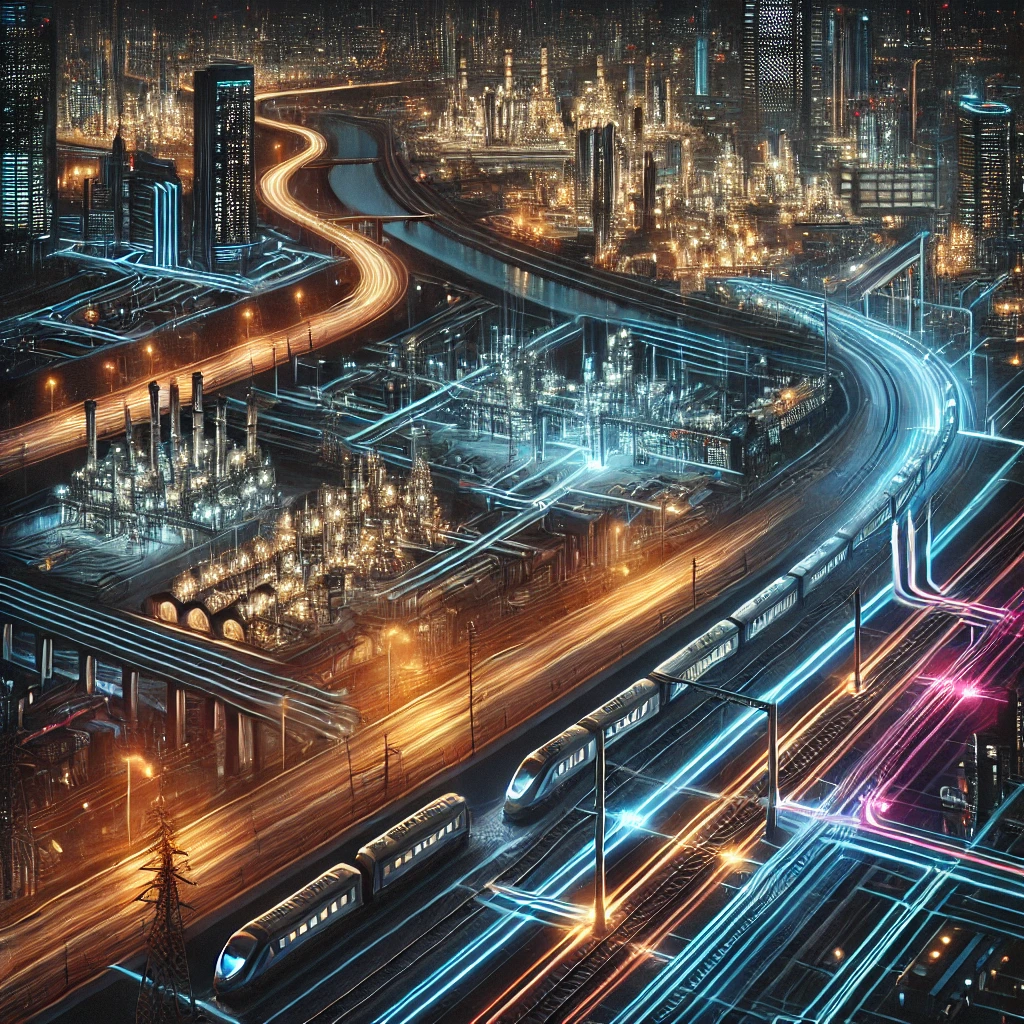Introduction
Industrial corridors are large infrastructure projects aimed at boosting industrialization, economic growth, and regional development. These corridors serve as growth engines by integrating industries, transport networks, and urbanization, leading to the holistic development of various regions in India. The government of India has launched several industrial corridor projects, such as the Delhi-Mumbai Industrial Corridor (DMIC), Bengaluru-Mumbai Economic Corridor (BMEC), and Chennai-Bengaluru Industrial Corridor (CBIC), to promote economic activities across different states.
This article examines the impact of industrial corridors on regional development in India, highlighting their role in economic transformation, job creation, infrastructure development, and balanced regional growth.
Understanding Industrial Corridors
What Are Industrial Corridors?
Industrial corridors are planned infrastructure zones that connect key industrial hubs through high-speed transportation networks, such as expressways, railways, and ports. These corridors aim to:
- Facilitate seamless movement of goods and services
- Promote manufacturing and exports
- Attract foreign and domestic investments
- Boost urbanization and infrastructure growth
- Reduce regional economic disparities
Major Industrial Corridors in India
The Indian government has initiated several industrial corridors under the National Industrial Corridor Development Programme (NICDP). The key corridors include:
- Delhi-Mumbai Industrial Corridor (DMIC)
- One of the biggest infrastructure projects in India
- Covers six states: Delhi, Uttar Pradesh, Haryana, Rajasthan, Gujarat, and Maharashtra
- Includes smart cities and modern industrial hubs
- Chennai-Bengaluru Industrial Corridor (CBIC)
- Aims to strengthen manufacturing industries in Tamil Nadu, Karnataka, and Andhra Pradesh
- Focus on automobile, electronics, and textile industries
- Bengaluru-Mumbai Economic Corridor (BMEC)
- Connects the IT hub of Bengaluru with the financial capital Mumbai
- Promotes high-tech industries and logistics
- Amritsar-Kolkata Industrial Corridor (AKIC)
- Enhances industrialization in Punjab, Haryana, Uttar Pradesh, Bihar, Jharkhand, and West Bengal
- Focus on agro-based industries and heavy manufacturing
- Vizag-Chennai Industrial Corridor (VCIC)
- Boosts coastal industrial development in Andhra Pradesh and Tamil Nadu
- Strengthens port-led industries and trade
These corridors are expected to transform India’s economic landscape by improving regional industrial capacities and infrastructure.
Impact of Industrial Corridors on Regional Development
1. Economic Growth and Industrialization
Industrial corridors serve as economic multipliers by attracting investments, setting up new industries, and expanding trade opportunities.
- Increased GDP Contribution: Regions with industrial corridors witness higher GDP growth due to large-scale production activities.
- Manufacturing Sector Boost: The ‘Make in India’ initiative benefits from these corridors as they promote domestic production.
- Export Promotion: Improved logistics and supply chains facilitate seamless exports, making India globally competitive.
Example: The DMIC has contributed significantly to Gujarat and Maharashtra’s industrial growth, making them key players in India’s manufacturing sector.
2. Employment Generation
One of the most significant impacts of industrial corridors is job creation.
- Direct Jobs: Industrial corridors create millions of direct jobs in manufacturing, logistics, and services.
- Indirect Employment: Ancillary industries, construction, and trade benefit from increased industrial activities.
- Skill Development: Initiatives like skill development centers near industrial hubs help enhance employability.
Example: The CBIC has led to the establishment of multiple automobile manufacturing units in Tamil Nadu, generating thousands of jobs.
3. Infrastructure Development
Industrial corridors drive large-scale infrastructure development, including:
- Roads and Expressways: High-speed transport networks improve connectivity between industrial hubs.
- Rail and Freight Corridors: Faster movement of goods enhances trade efficiency.
- Smart Cities: Industrial corridors lead to the development of planned urban areas with modern amenities.
- Power and Water Supply: Reliable energy and water resources support industrial and residential needs.
Example: The Sagarmala initiative, linked to coastal industrial corridors, has improved port connectivity, enhancing India’s maritime trade.
4. Balanced Regional Growth
One of the key objectives of industrial corridors is to reduce regional economic disparities by:
- Encouraging development in backward regions
- Reducing migration pressure on metropolitan cities
- Promoting inclusive growth across states
Example: The AKIC aims to bring economic development to eastern states like Bihar and Jharkhand, which have lagged behind western states in industrialization.
5. Urbanization and Real Estate Growth
As industrial corridors develop, they attract urban settlements, leading to:
- Growth of new cities and townships
- Expansion of commercial and residential real estate
- Improvement in living standards due to better amenities
Example: The DMIC has led to the development of new smart cities like Dholera in Gujarat.
6. Boost to MSMEs and Startups
Industrial corridors provide opportunities for Micro, Small, and Medium Enterprises (MSMEs) and startups by:
- Creating special economic zones (SEZs)
- Providing access to better logistics and supply chains
- Encouraging technology-driven industries
Example: The BMEC has promoted IT startups and high-tech industries in Bengaluru and Pune.
Challenges in Implementing Industrial Corridors
1. Land Acquisition Issues
- Industrial corridors require large areas of land, leading to land acquisition conflicts with farmers and local communities.
- Example: Protests against land acquisition for the DMIC in Haryana and Maharashtra.
2. Environmental Concerns
- Industrial expansion may lead to deforestation, pollution, and water depletion.
- Solution: Green industry initiatives and sustainable planning.
3. Infrastructure Bottlenecks
- Delays in road, rail, and power projects slow down industrial corridor development.
- Need for faster policy implementation and private investment.
4. Unequal Benefits Across States
- Some states benefit more than others due to better governance and investor-friendly policies.
- Need for balanced policy measures to ensure fair distribution of benefits.
5. Dependence on Foreign Investment
- Many industrial corridors depend on foreign direct investment (FDI).
- Economic fluctuations and global trends can impact investments.
Strategies for Maximizing the Benefits of Industrial Corridors
1. Faster Policy Implementation
- Simplify land acquisition laws
- Reduce bureaucratic delays in approvals
2. Sustainable Industrial Growth
- Promote green manufacturing and energy-efficient industries
- Implement strict pollution control measures
3. Skill Development and Training Programs
- Establish technical institutes near industrial corridors
- Provide vocational training to enhance workforce readiness
4. Strengthening MSMEs and Local Industries
- Provide financial incentives and subsidies to MSMEs
- Promote local entrepreneurship and innovation hubs
5. Public-Private Partnerships (PPPs)
- Encourage private sector participation in infrastructure development
- Attract foreign investments for advanced technology adoption
Conclusion
Industrial corridors have emerged as a transformative tool for regional development in India. They drive industrialization, create jobs, improve infrastructure, and reduce regional imbalances. However, challenges such as land acquisition, environmental concerns, and infrastructure delays need to be addressed for their full potential to be realized.
By implementing sustainable policies, investing in skill development, and promoting inclusive growth, India can leverage industrial corridors to achieve long-term economic prosperity and balanced regional development.




